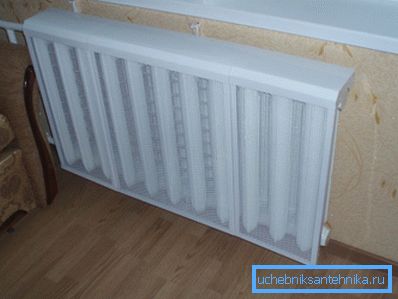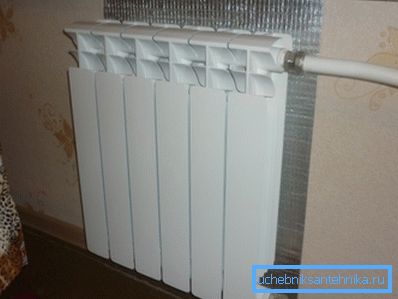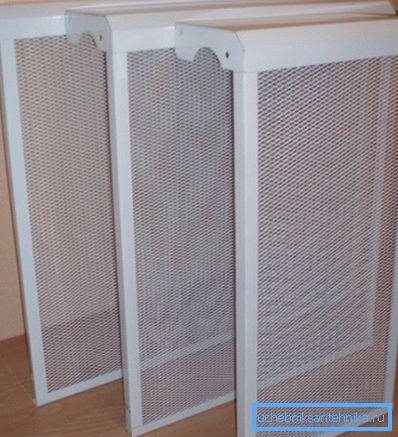Screens for heating radiator: materials, purpose, types of
Together with a huge range of heating devices, today screens for radiators are available to consumers, which are able to significantly transform these elements of the heating system. They help to give a conventional battery a decorative look, making it an integral part of the interior. Below we will talk about what materials such products are made of, what types and forms exist, as well as about the main purpose of screens and how to install them correctly in a room.

General information
- The screen for the radiator is a decorative product designed to improve the appearance of the heater, regardless of its type.
Tip: With this accessory, you can even turn the oldest battery into a work of art.
- It can be made of a different material, which allows you to endow each product with its unique qualities:
| Metal | Such protective screens for radiators in addition to the decorative function are endowed with other useful qualities. One of the most important is the property of the metal to transfer heat, significantly increasing the heat transfer of the radiator. Such decorative elements are durable and reliable, therefore they are able to decorate a battery for the whole period of its service. |
| Plastic, wooden | They are not as practical as the previous version, but they also attract consumers with their appearance and variety. An important role in this case is played by the price of such elements, which is an order of magnitude lower than metal structures. |
Tip: before you buy for the beauty and low cost of decorative elements, make sure they are resistant to high temperatures.
Materials
- Thin sheets of steel are used for the production of metal screens., which, no matter what, are of high strength. Finished products are painted with powder paint, which gives a decorative effect and performs protective functions, preventing direct effects on the finished products of high temperatures and other negative factors. Despite the low cost, these models are of high quality, which allows them to be used not only in residential premises, but also in production.

In the manufacture can be used and stainless steel. However, the cost of such products, as well as performance, is somewhat higher. Even under the influence of very high temperatures, such screens are not deformed, due to which their long service life is guaranteed.
- Wooden protective screens are equally popular., which, unlike metal, can become an ornament to any interior, regardless of the style used. This is a natural material, the naturalness of which guarantees the absence of harmful substances in the air when heated.

If desired, each consumer can choose a screen for the radiator, for the manufacture of which used valuable wood. If this luxury is not affordable, then screens made of MDF or chipboard will be a very rational choice.
- Plastic or PVC screens are very light and practical.. Stylish appearance allows you to use them as an element of decor in any room, whatever its purpose - a living room or office.

Purpose
Consider two main functions:
- Decorative, as mentioned above, allowing you to hide existing battery defects, and making it look more attractive. Regardless of the premises in which the products are installed, a variety of models will help to create exactly the atmosphere that is required.
- Protective, which is the main one. Having become an element of decor, such a screen can reduce the level of infrared radiation and radiation emitted by heating devices several times. In winter, when the temperature of the coolant is much higher, the batteries are heated up so that by touching them, the probability of getting a burn is high. A screen mounted on a radiator will reduce this probability to zero.
The use of decorative protective screens for radiators is important in any buildings and premises. They can be used in homes, creating the necessary comfort, or in office space, giving them austerity. Often they are installed in industrial plants, hiding unsightly heating systems from prying eyes, and making the appearance of production premises more presentable.
Decorative screens allow you to instantly solve the problem of the ugliness of heating systems, which are still installed in houses owned by the old fund. If before people had to get out of the situation by laborious installation of furniture boxes, now it is enough to install a protective structure of this type for each radiator.

Varieties of forms
The choice of modern screens for radiators will satisfy even the most demanding consumers, since their shapes and sizes can be very diverse.
Their description will take too much time and space, you should focus only on the main types, which include:
- flat - consist of a frame and crates, designed for batteries that are in the wall niche;
- mounted screens for metal radiators with an open bottom and sides are distinguished by their versatility, as they are suitable for any type of battery;
- box with an opening lid that provides easy access to the heating device.
Installation
Instructions for installing a protective screen on the radiator is simple:
- Mark the attachment points by marking the wall with fasteners.
- Drill holes.
- Fix the product on the wall using screws on the tree, or using a self-tapping screw-dowel system.
Hinged option
There are also other types of screens - mounted, which, when installed, do not have to spoil the walls. Due to its special shape, capable of clinging to objects, they are simply hung on radiators.

It should be noted that in some cases it is necessary to ensure unimpeded penetration to the radiators. Most often interact with batteries accounted for residents of private homes. And here mounted screens are the perfect choice. They are able to perform their direct functions without interfering with getting to the viscera.
Screen box
The most difficult is the process of assembling screens-boxes, installation of which is carried out directly near the radiators. Since the design covers the battery from all sides, you need to consider the location of the walls, and where the pipeline goes. Taking into account all these features, in some cases it is necessary to make changes in the design of the box.

Screen in a niche
It should also take into account some features of mounting screens on radiators located in wall niches. For them, you will need to additionally purchase special furniture brackets that will provide the structure with a flat surface.
In addition, you can be smart and make the screen flip or open. Then you may need special chains on which it will be attached either to the battery or to the wall. Going to the furniture store, you can find a variety of accessories that will allow him to act as opening doors.

Conclusion
If you want to hide a heating radiator in the interior, a protective screen will help you, which in addition to this performs several other useful functions, in particular, protects households from contact with the very hot surface of the heating device.
Today such structures are made of metal, wood or plastic of different types, shapes and sizes, therefore, it is easy to find a suitable one. The video in this article will allow you to find additional information on the above topic.